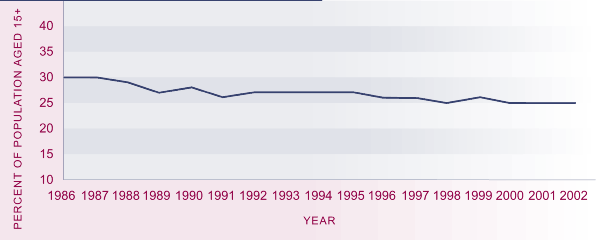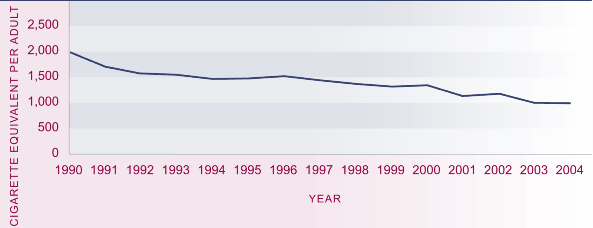Prevalence of cigarette smoking
Definition
The proportion of the population aged 15 and over who currently smoke
cigarettes.
Relevance
Tobacco smoking is a well-recognised risk factor for many cancers
and for respiratory and cardiovascular diseases. In addition, exposure to
environmental tobacco smoke (particularly maternal smoking) has been identified
as a major
risk factor for Sudden Infant Death Syndrome (SIDS) and respiratory problems
in children. Internationally, smoking has been identified as the major cause
of preventable death in OECD countries.23
Current level and trends
In 2002, 25 percent of New Zealanders aged
15 years and over were cigarette smokers. The prevalence of smoking has declined
from 30 percent in 1986, with most of the decline occurring between 1987 and
1991.
Figure H4.1 Prevalence of cigarette smoking, 1986–2002

Source: Ministry of Health (2003b) Appendix 1, Table 11
Age and sex differences
Smoking is most prevalent among people
aged 25–34 years, followed by those aged 15–24 years and those aged 35–54.
Older people aged 55 and over are much less likely to smoke and have experienced
the greatest
decline in smoking prevalence over the past 15 years.
Smoking prevalence has been similar for both sexes since the mid-1980s.
In 2002, the rate was 25 percent for males and 24 percent for females. Females
are slightly more likely than males to smoke at ages 15–34, but for those aged
35 and over, smoking has generally been more prevalent among males; over the
1990s, both sexes became less likely to smoke.
Ethnic differences
Māori women have
the highest smoking prevalence (52 percent), followed by Māori men (39 percent). Among Pacific peoples, smoking is more prevalent among
men (35 percent) than among women (29 percent).
Since the early 1990s, smoking prevalence has declined by about three
percentage points for European/Other ethnic groups but has remained relatively
unchanged for Māori and Pacific peoples.24
Table H4.1 Age-standardised prevalence of cigarette smoking, by
sex and ethnicity, 2002
| |
Percentage in each ethnic group who smoke cigarettes |
| Māori |
Pacific peoples |
European/Other |
Total |
| Male |
39.3 |
34.6 |
23.8 |
26.2 |
| Female |
51.9 |
28.5 |
20.6 |
25.5 |
| Total |
46.4 |
31.9 |
22.1 |
25.8 |
Source: Ministry of Health (2003b) Table 1
Note: Rates are age-standardised using the WHO world population
Socio-economic differences
Smoking is more prevalent among those with
lower incomes, beneficiaries and those living in the most
deprived areas. An analysis of 1996 Census data shows that the proportion of
smokers in the most deprived
(decile 10) areas is two to three times the proportion of smokers in the least
deprived (decile 1) areas for all age groups, and for both sexes.25
International comparison
In a 2001 comparison of the prevalence of
adult smoking, New Zealand had a rate of 25 percent, compared with an OECD median of
27 percent.26 New Zealand ranked eighth best out of 17 OECD countries. Smoking prevalence was worst in
the Netherlands (34 percent). New Zealand's rate was slightly better than that of the United Kingdom (27 percent), but considerably worse than those of Australia (19.8 percent), the United States (18.5 percent) and Canada (18.0 percent). When compared to other developed countries, New Zealand smoking levels are relatively low for males and relatively high for females.27
Tobacco consumption
Tobacco consumption can be measured from customs data
or tobacco company returns. This complements the information on smoking prevalence
outlined above, so providing a more comprehensive assessment of tobacco use.
When expressed as cigarette equivalents per person aged 15 years and over per
year, there has been a decrease of 26 percent in tobacco consumption over the
last five years, from 1,352 to 999 cigarette equivalents per person. The drop
in tobacco consumption has been more rapid than the drop in smoking prevalence.
Figure H4.2 Tobacco consumption, cigarette equivalent per person
aged 15 years and over, 1990–2004

Source: Ministry of Health
|


